
Many people wonder: what is the best macaron recipe that could help them succeed? These little delights are truly dreamy, but their reputation for being difficult and finicky puts many off. Yet, once you dare to try, the satisfaction is immense. Watching the famous feet (the ruffled “skirt” that forms at the base of the macaron shell) appear through the oven window is absolutely magical!
I’m sharing with you the Italian meringue macaron recipe by French chef Christophe Felder, which helped me succeed on my very first try. Through my experiences, I’ve also gathered all the essential tips that can help you achieve homemade macarons as beautiful and delicious as those from specialized shops.
This recipe will allow you to make them for all tastes, like these lemon macarons with two different lemon ganaches.
With a few tricks and some practice, you’ll see that making perfect homemade French macarons is entirely possible!
The article is quite long, but you’ll find a table of contents below that can guide you.
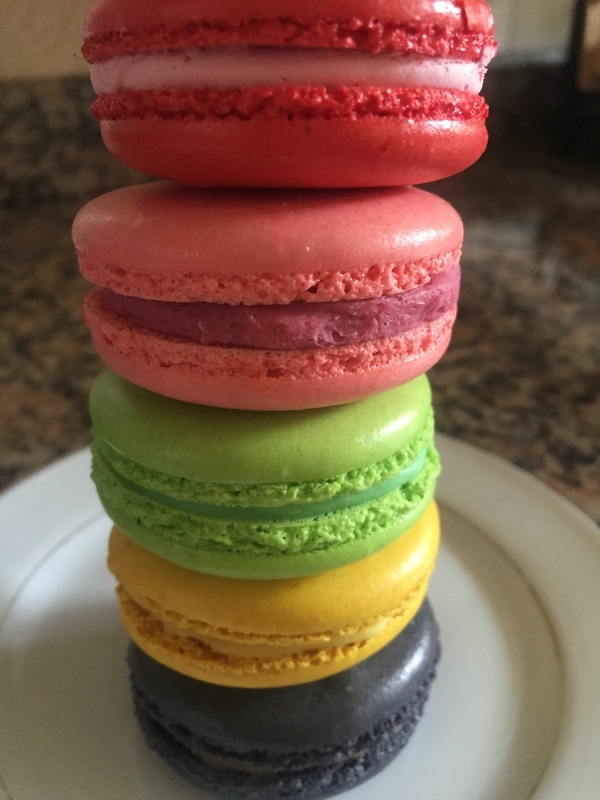
Table of Contents
Tips
If you’re just starting out, begin with French meringue macarons. This method is quicker and less intimidating than Italian meringue. Once you’ve mastered the macaronage technique, you can move on to Italian meringue, which will become easier to get right with practice.
Macarons are delicate and temperamental pastries. A single misstep can lead to imperfect shells. Pay close attention to each stage, from macaronage to baking. Good technique and precise movements make all the difference.

Ingredients:
NB: Find all the tips and tricks I recommend reading before getting started, as well as the printable recipe card at the end of the article.
For about 40 macarons
- 150 g egg whites (75 g +75 g), aged for 2 to 3 days, room temperature
- 200 g granulated sugar
- 200 g of almond flour (if the almond flour is not fine enough and you need to blend and sift it with the powdered sugar, add 10 to 15% more of both the almond flour and the powdered sugar).
- 200 g powdered sugar
- 50 ml water
- 20 g sugar (to stabilize the egg whites before adding the syrup)
- Water-soluble powdered or gel food coloring
Ganache for about 20 macarons
- 150 g white chocolate (preferably in chips or pistoles)
- 75 ml heavy cream
- 8 g honey
- 10 g unsalted butter
- Flavoring of your choice (mine is also colored to match the flavor)
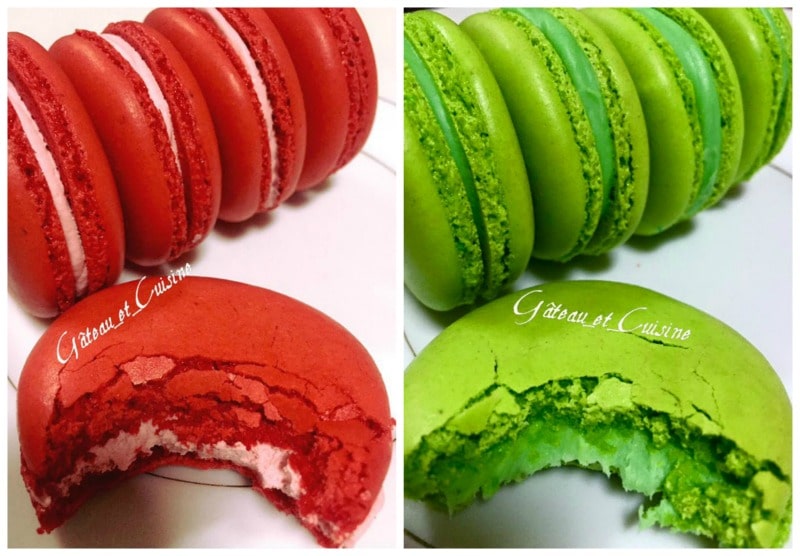
Preparation steps :
Prepare the tant pour tant:
Use 210 g of almond flour and 210 g of powdered sugar. After grinding and sifting them, you should retain the total weight required for the recipe, that is, a tant pour tant (equal parts almond flour and powdered sugar) of 400 g.
Pulse the almond flour with the powdered sugar in batches to avoid heating the mixture. Stop the food processor once or twice to stir. The mixture should not heat up. Then sift it into a bowl or onto a sheet of parchment paper, and weigh out the amount needed for the recipe.
Preparing the Macarons
If your granulated sugar isn’t very fine, sift it.
Use aged egg whites (separated from the yolks) that have been stored in the refrigerator in an airtight container for 3 to 4 days. Take them out the night before, or at least 2 hours ahead of time, so they reach room temperature.
Personally, I separate the egg whites just the day before and haven’t noticed any difference.
For the syrup, pour 50 ml of water into a small saucepan, then add the 200 g of granulated sugar. Insert a thermometer into the pan to monitor the temperature.
Place 75 g of egg whites in the bowl of a stand mixer fitted with a whisk attachment, or in a large mixing bowl if using a hand mixer. Keep the 20 g of granulated sugar close at hand.
Heat the water and sugar mixture over low heat until it reaches 118°C to 119°C (244–246°F), then remove it from the heat.
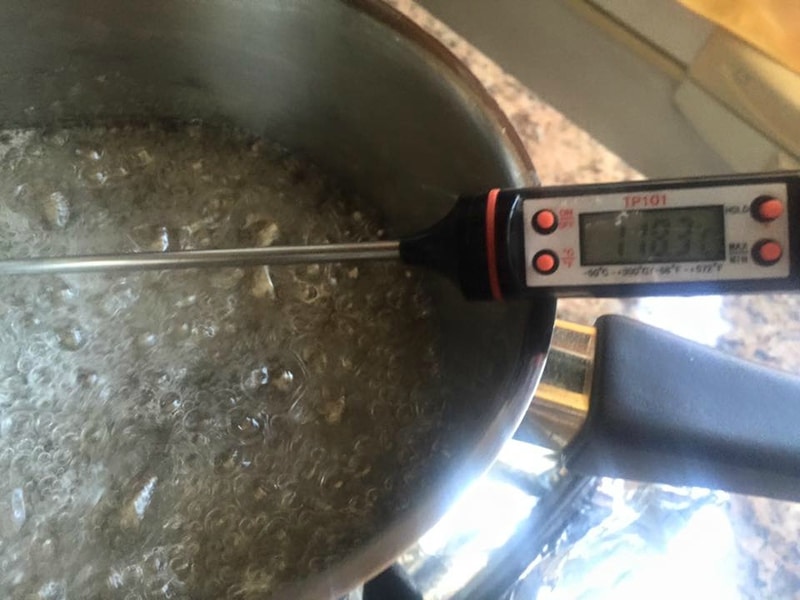
When the syrup reaches around 90°C (even though some chefs recommend starting at 114°C, it often hits 118°C before the egg whites are fully whipped), begin beating the 75 g of egg whites on low speed in the stand mixer bowl. Gradually increase the speed, and add the 20 g of granulated sugar in 2 or 3 additions as soon as the egg whites start to foam.
When the syrup approaches 117°C, increase the mixer speed so the egg whites reach stiff peaks by the time the syrup hits 118°C.
Reduce the mixer speed and slowly pour the syrup in a steady stream down the side of the bowl (avoiding the whisk), so it blends gradually into the meringue.
Then increase the speed to maximum (speed 10 on a KitchenAid) and whisk until the meringue cools slightly, to about 40°C, just warmer than body temperature to the touch.
The meringue should be smooth, glossy, and form soft peaks (known as the “bird’s beak”). If you’re only using one color, add the powdered food coloring just before stopping the mixer so it incorporates evenly. Otherwise, add the coloring directly to the tant pour tant mixture.
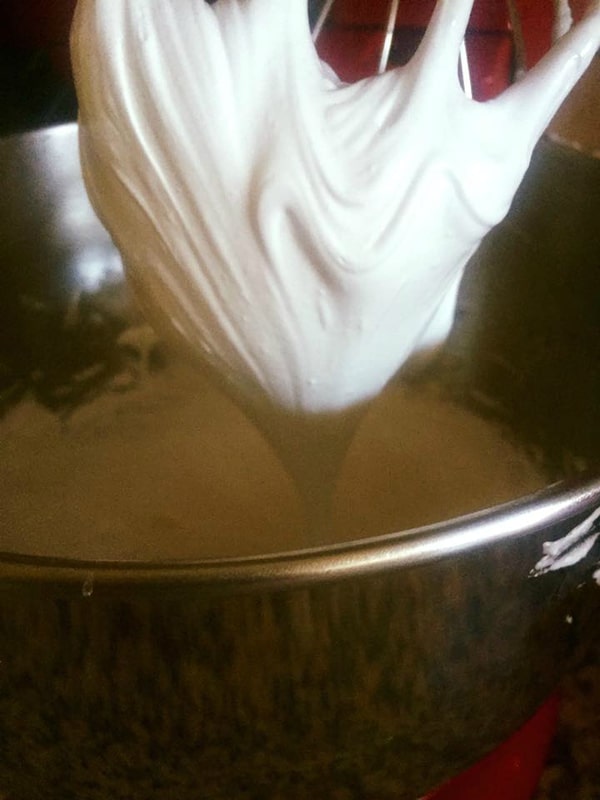
While preparing the meringue, mix the remaining 75 g of egg whites with the tant pour tant, as well as with the food coloring if you haven’t added it to the meringue.
Mix well until you have a smooth batter. Slightly intensify the desired color, as it will fade during baking.
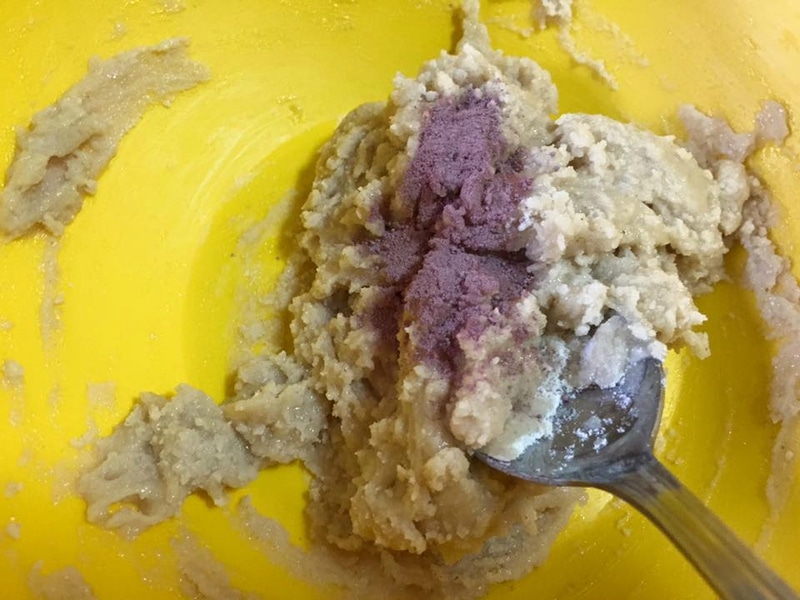
Pour a little meringue into the almond mixture, then, using a spatula, gently fold it in using the “J fold” technique. This involves making a bottom-up motion, starting from the center and moving towards the edges, while scraping the sides of the bowl. Then, add the rest of the meringue and incorporate it the same way, turning the bowl.
Macaronage by pressing the mixture against the sides of the bowl. The batter should form a ribbon when it falls from the spatula. It should not be too runny or too thick. The batter should flow smoothly in a stream, and when you make a line with the spatula in the bowl, it should smooth out and become smooth and shiny again.
Note : If you’d like to do the macaronage using a stand mixer, start by beating the meringue until it forms stiff peaks (bird’s beak stage), and add the coloring at this point if using. Then incorporate the remaining 75 g of egg whites and mix just until combined.
Next, switch the whisk attachment for the paddle (K) attachment, add the almond-sugar mixture (tant pour tant) all at once, and run the mixer in 30-second intervals, checking the texture in between.
The batter should flow in a ribbon when lifted. It’s best to stop just before the ideal consistency is reached and finish the macaronage by hand with a spatula to avoid overmixing and ending up with a runny batter.
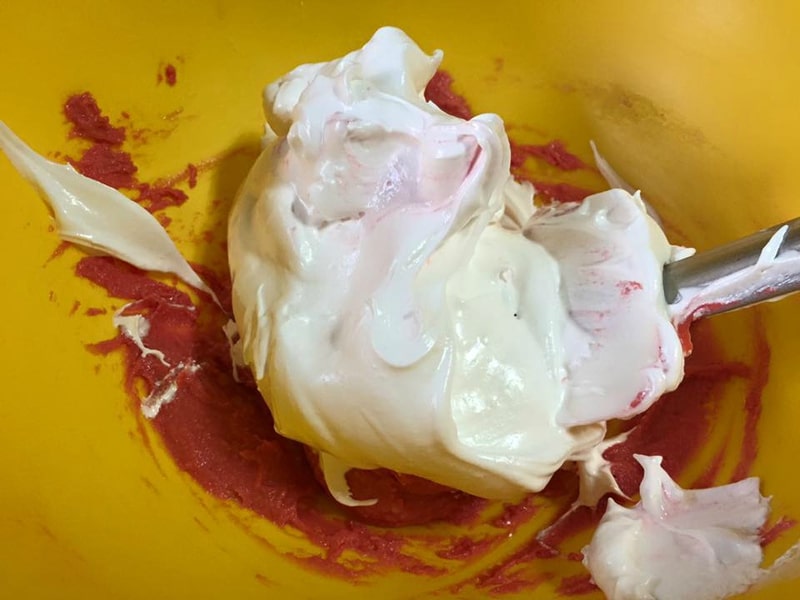
Pipe the batter into a piping bag fitted with a #8 round tip. Pipe small circles about 2 to 3 cm, depending on the size of macarons you want, onto a baking tray lined with parchment paper, a Silpat, or preferably, fiberglass baking sheet. fiberglass baking mats.
Note: To make piping easier, you can draw small circles (3 cm or less) on a sheet of parchment paper to use as a template. Simply place this sheet under your baking liner while piping, then remove it before baking.

Gently tap the baking sheet from underneath to smooth out the macarons and release any air bubbles.
Let them dry (“crust”) in a dry room, away from kitchen humidity, for 30 minutes to 1 hour. When you lightly touch the surface of a macaron with your finger, it should feel dry.
Some people, like Mercotte, don’t let Italian meringue macarons rest before baking, but I prefer following the chef’s tips.
Preheat the oven to 150°C (300°F) with convection (fan-assisted) heat, and bake for 12 to 14 minutes.
Normally, after about 5 to 6 minutes, the feet (the characteristic frilly base) will appear. Around 7 minutes in, once the feet have formed, briefly open the oven to release steam, this helps prevent the macarons from cracking. Open for just a few seconds, then close again.
If you notice the macarons browning too much, your oven may be too hot, lower the temperature to 140°C (285°F) or even less. Keep an eye on them and take notes for the next batches.
Once out of the oven, remove the parchment paper or baking mat from the tray immediately. Let the macarons cool completely before removing them.
Ganache for about 20 macaroons
Melt the chocolate slightly in a double boiler. In the meantime, bring the cream and honey to a boil. Once it starts to simmer, remove from the heat.
Off the heat, incorporate the cream into the chocolate in three stages, mixing well to emulsify. Add the butter and your choice of flavoring.
Blend with an immersion blender. Transfer to a piping bag and let it firm up before using. I recommend leaving it at room temperature for 2 to 3 hours.
Garnish macarons
Assemble the matching shells two by two. Fill half of them with the ganache, then close with the second half of the shells.
Place them on a tray and refrigerate for at least 6 hours before transferring to an airtight container. It is recommended to wait at least until the next day to enjoy them, as the macarons will be much softer and even better after 24 hours of resting.
Store them in an airtight container in the refrigerator.
I hope my explanations will be very helpful to you and that you will make beautiful macarons. I am available for any questions you may have.
Happy baking!
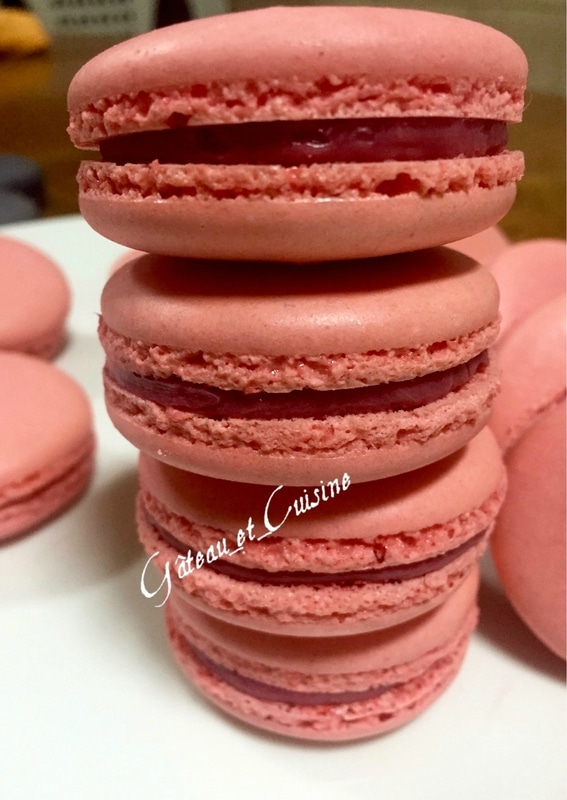
IMPORTANT: Tips and Tricks for Successful Macarons
1. Prepare the tant pour tant before weighing in the recipe. Use an equal weight of almond flour and powdered sugar (e.g., 1kg of almond flour and 1kg of powdered sugar). Blend, stirring occasionally. The mixture must not heat up. Sift and stir well to combine. The tant pour tant is now ready. You can use it in any recipe that calls for an equal weight of powdered sugar and almond flour.
2. Use egg whites at room temperature. Clarify them the day before for the next day. Take them out of the refrigerator at least 2 hours before starting.
3. The granulated sugar should be very fine. If it is not, sift it to remove any large pieces.
4. When working with macarons, especially if you have high humidity, it’s best to work in the morning. Avoid doing dishes nearby or move the macarons to another room to let them rest (crust) away from humidity.
5. Be careful not to make the macaron batter too liquid when macaroning. The macaron mixture should fall gently from the spatula in a ribbon-like manner. You need to watch carefully; when you touch the batter with the spatula, it should smooth out and form a smooth pile.
6. It’s best to use a stand mixer, like a KitchenAid. You can use a handheld mixer, but you need to hold it upright to avoid incorporating too much air. Do not tilt it when beating the egg whites.
7. Add the food coloring to the meringue if you’re making a single color. Otherwise, color the almond flour mixture.
8. Tap the baking tray lightly to smooth the tops of the macarons and remove any stubborn peaks. You can also drop the tray onto the work surface. This action also helps to burst air bubbles. If the batter spreads by itself, don’t tap too much.
9. Letting the macarons crust is important if you want to give yourself the best chance of success. Allow them to crust away from dishes and any humidity. When you touch the macaron, your finger should remain dry.
10. The baking temperature provided is for dark-colored macarons. For white or light-colored macarons, reduce the temperature to 125°C (257°F ) and increase the baking time. This can vary from oven to oven. To check if the macarons are done, the shell should be firmly attached to the feet. When you move the top of the macaron, it should not budge. Flip the parchment paper slightly to check if they’re done.
11. For my oven, which tends to heat too much, I keep the baking tray at the top. This prevents my macarons from browning. I bake my macarons on the second rack from the bottom, not in the middle, because my oven doesn’t cook well from the bottom.
12. To give yourself the best chance of achieving a nice “feet” (collarette), place a tray on the oven rack before preheating the oven. You will place your tray with the macarons on top of this one. Some people use two stacked trays that are preheated in the oven, with one containing the macarons. It’s up to you to experiment and see the results.
13. Use a flexible silicone spatula (Maryse) to handle the meringue without deflating it.
14. Use trays with no edges or place the parchment paper on the back of the tray.
15. I tried the same recipe using static heat instead of fan-assisted, and I got the same result, except the baking time was a bit longer. The “feet” usually appear around 7-8 minutes.
16. Let the macarons cool before filling them. Once filled with ganache, leave them on a tray in the fridge for at least 6 hours before storing them in an airtight container. They can be frozen with the ganache or just the shells. They store very well and defrost quickly.
17.
a) You can use the same recipe to make two colors at once. Divide the tant pour tant into two bowls, split the 75 g of egg whites into two, and add a portion of your chosen food coloring to each bowl. Mix well.
b) Weigh the Italian meringue and divide it into two equal portions.
c) Add one portion of the meringue to each bowl and gently fold the mixture together (this is the process of “macaroning”).

Do you need aged egg whites?
Many recipes recommend using egg whites that have been separated from the yolks and stored in the refrigerator for 3 to 4 days in an airtight container. Of course, following this tried-and-true method can be reassuring to achieve great macarons. However, it’s not essential: you can still successfully make macarons with egg whites that are clarified on the same day, as long as they are at room temperature.
The most important factor in making successful macarons is that the egg whites are at room temperature.
If your eggs were in the refrigerator, take them out the day before or at least 2 hours before using them. Frozen egg whites also work: just defrost them the day before.
Personally, I separate the egg whites just the day before, and I don’t notice any difference in the final result.
How to properly macaronage?
Macaronage is crucial for achieving smooth and shiny shells. It involves incorporating the almond powder and sugar (tant pour tant) into the meringue. Use a silicone spatula (maryse), a scraper (corne), or the K-beater from a stand mixer on low speed, making pauses every 5 seconds to check the texture.
Incorporate the almond powder into the meringue by lifting the mixture from the bottom up and pressing it against the sides of the bowl. The goal is to smooth the batter, making it shiny and flexible. The batter should fall in a continuous ribbon from the maryse.
If the batter is too runny, it will spread during piping, and if it’s too firm, it will create rough shells. If the texture is right, the piped mounds will spread slightly and have a smooth, shiny top.
A tip: I often add a small portion of meringue to the tant pour tant to loosen the mixture, then incorporate the rest of the meringue to finish macaronage.
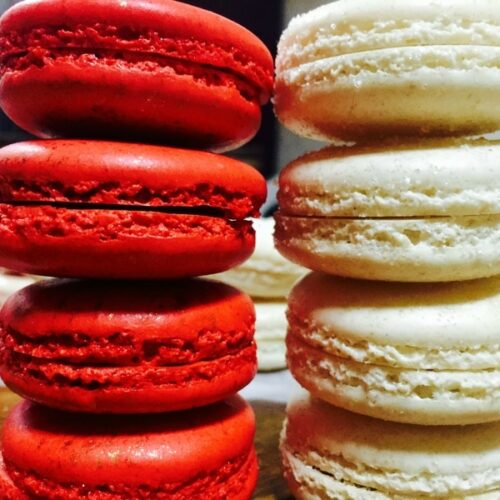
French Macarons-the best recipe
INGREDIENTS
For about 40 macarons
- 150 g (75 g+ 75 g ) egg whites aged for 2 to 3 days, room temperature
- 200 g granulated sugar
- 200 g almond flour if the almond flour is not fine enough and you need to blend and sift it with the powdered sugar, add 10 to 15% more of both the almond flour and the powdered sugar.
- 200 g powdered or confectioners sugar
- 50 ml water
- 20 g sugar to stabilize the egg whites before adding the syrup
- Water-soluble powdered or gel food coloring
Ganache for about 20 macarons
- 150 g white chocolate preferably in chips or pistoles
- 75 ml heavy cream
- 8 g honey
- 10 g unsalted butter
- Flavoring of your choice mine is also colored to match the flavor
PREPARATION
Prepare the tant pour tant:
- Use 210 g of almond flour and 210 g of powdered sugar. After grinding and sifting them, you should retain the total weight required for the recipe, that is, a tant pour tant (equal parts almond flour and powdered sugar) of 400 g.
- Pulse the almond flour with the powdered sugar in batches to avoid heating the mixture. Stop the food processor once or twice to stir. The mixture should not heat up. Then sift it into a bowl or onto a sheet of parchment paper, and weigh out the amount needed for the recipe.
Preparing the Macarons
- If your granulated sugar isn't very fine, sift it.
- Use aged egg whites (separated from the yolks) that have been stored in the refrigerator in an airtight container for 3 to 4 days. Take them out the night before, or at least 2 hours ahead of time, so they reach room temperature.
- Personally, I separate the egg whites just the day before and haven’t noticed any difference.
- For the syrup, pour 50 ml of water into a small saucepan, then add the 200 g of granulated sugar. Insert a thermometer into the pan to monitor the temperature.
- Place 75 g of egg whites in the bowl of a stand mixer fitted with a whisk attachment, or in a large mixing bowl if using a hand mixer. Keep the 20 g of granulated sugar close at hand.
- Heat the water and sugar mixture over low heat until it reaches 118°C to 119°C (244–246°F), then remove it from the heat.
- When the syrup reaches around 90°C (even though some chefs recommend starting at 114°C, it often hits 118°C before the egg whites are fully whipped), begin beating the 75 g of egg whites on low speed in the stand mixer bowl. Gradually increase the speed, and add the 20 g of granulated sugar in 2 or 3 additions as soon as the egg whites start to foam.
- When the syrup approaches 117°C, increase the mixer speed so the egg whites reach stiff peaks by the time the syrup hits 118°C.
- Reduce the mixer speed and slowly pour the syrup in a steady stream down the side of the bowl (avoiding the whisk), so it blends gradually into the meringue.
- Then increase the speed to maximum (speed 10 on a KitchenAid) and whisk until the meringue cools slightly, to about 40°C, just warmer than body temperature to the touch.
- The meringue should be smooth, glossy, and form soft peaks (known as the "bird’s beak"). If you're only using one color, add the powdered food coloring just before stopping the mixer so it incorporates evenly. Otherwise, add the coloring directly to the tant pour tant mixture.
- While preparing the meringue, mix the remaining 75 g of egg whites with the tant pour tant, as well as with the food coloring if you haven’t added it to the meringue.
- Mix well until you have a smooth batter. Slightly intensify the desired color, as it will fade during baking.
- Pour a little meringue into the almond mixture, then, using a spatula, gently fold it in using the "J fold" technique. This involves making a bottom-up motion, starting from the center and moving towards the edges, while scraping the sides of the bowl. Then, add the rest of the meringue and incorporate it the same way, turning the bowl.
- Macaronage by pressing the mixture against the sides of the bowl. The batter should form a ribbon when it falls from the spatula. It should not be too runny or too thick. The batter should flow smoothly in a stream, and when you make a line with the spatula in the bowl, it should smooth out and become smooth and shiny again.
- Note : If you’d like to do the macaronage using a stand mixer, start by beating the meringue until it forms stiff peaks (bird’s beak stage), and add the coloring at this point if using. Then incorporate the remaining 75 g of egg whites and mix just until combined.
- Next, switch the whisk attachment for the paddle (K) attachment, add the almond-sugar mixture (tant pour tant) all at once, and run the mixer in 30-second intervals, checking the texture in between.
- The batter should flow in a ribbon when lifted. It's best to stop just before the ideal consistency is reached and finish the macaronage by hand with a spatula to avoid overmixing and ending up with a runny batter.
- Pipe the batter into a piping bag fitted with a #8 round tip. Pipe small circles about 2 to 3 cm, depending on the size of macarons you want, onto a baking tray lined with parchment paper, a Silpat, or preferably, fiberglass baking sheet. fiberglass baking mats.
- Note: To make piping easier, you can draw small circles (3 cm or less) on a sheet of parchment paper to use as a template. Simply place this sheet under your baking liner while piping, then remove it before baking.
- Gently tap the baking sheet from underneath to smooth out the macarons and release any air bubbles.
- Let them dry ("crust") in a dry room, away from kitchen humidity, for 30 minutes to 1 hour. When you lightly touch the surface of a macaron with your finger, it should feel dry.
- Some people, like Mercotte, don’t let Italian meringue macarons rest before baking, but I prefer following the chef’s tips.
- Preheat the oven to 150°C (300°F) with convection (fan-assisted) heat, and bake for 12 to 14 minutes.
- Normally, after about 5 to 6 minutes, the feet (the characteristic frilly base) will appear. Around 7 minutes in, once the feet have formed, briefly open the oven to release steam, this helps prevent the macarons from cracking. Open for just a few seconds, then close again.
- If you notice the macarons browning too much, your oven may be too hot, lower the temperature to 140°C (285°F) or even less. Keep an eye on them and take notes for the next batches.
- Once out of the oven, remove the parchment paper or baking mat from the tray immediately. Let the macarons cool completely before removing them.
Ganache for about 20 macaroons
- Melt the chocolate slightly in a double boiler. In the meantime, bring the cream and honey to a boil. Once it starts to simmer, remove from the heat.
- Off the heat, incorporate the cream into the chocolate in three stages, mixing well to emulsify. Add the butter and your choice of flavoring.
- Blend with an immersion blender. Transfer to a piping bag and let it firm up before using. I recommend leaving it at room temperature for 2 to 3 hours.
Garnish macarons
- Assemble the matching shells two by two. Fill half of them with the ganache, then close with the second half of the shells.
- Place them on a tray and refrigerate for at least 6 hours before transferring to an airtight container. It is recommended to wait at least until the next day to enjoy them, as the macarons will be much softer and even better after 24 hours of resting.
- Store them in an airtight container in the refrigerator.
- I hope my explanations will be very helpful to you and that you will make beautiful macarons. I am available for any questions you may have.
- Happy baking!
Thank you for your visit and your comments!
